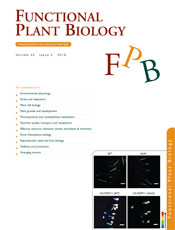
Functional Plant Biology
Volume 43 Number 3 2016
FP15090Arabidopsis thaliana constitutively active ROP11 interacts with the NADPH oxidase respiratory burst oxidase homologue F to regulate reactive oxygen species production in root hairs
Root hairs are important for the uptake of water and nutrients, and plant anchorage. We found that the constitutively active small guanosine triphosphatase (GTPase) ROP11 interacted with respiratory burst oxidase homologue F to regulate reactive oxygen species (ROS) production in root hairs of Arabidopsis thaliana (L). Heynh. The study reveals a functional connection between GTPase and ROS that is essential for the development of root hairs.
FP15292Overexpression of human peroxisomal enoyl-CoA delta isomerase2 HsPECI2, an ortholog of bamboo expressed during gregarious flowering alters salinity stress responses and polar lipid content in tobacco
Apart from the primary role of Peroxisomal enoyl-CoA delta isomerase 2 (PECI2) in the oxidation of polyunsaturated fatty acids (PUFAs), it also modulates normal plant development, ABA responses and response to high NaCl concentration via manipulation of the levels and content of various polar lipids when overexpressed in tobacco.
FP15120Nitric oxide participates in waterlogging tolerance through enhanced adventitious root formation in the euhalophyte Suaeda salsa
The roles of adventitious roots in plants suffering flooding and root organogenesis have been major issues for decades. The function of NO in waterlogging tolerance is unclear. NO increases waterlogging tolerance through enhanced adventitious root formation and NO increase via the upregulation of nitric oxide synthase activity in Suaeda salsa under waterlogging. Understanding the mechanisms of plant waterlogging tolerance will be helpful for improving agricultural production.
FP15330Salt effects on proline and glycine betaine levels and photosynthetic performance in Melilotus siculus, Tecticornia pergranulata and Thinopyrum ponticum measured in simulated saline conditions
Salinity stressed plants synthesise increased concentrations of organic compounds in their cells, in particular, glycine betaine and proline. We examined three economically important salt-adapted pasture species: messina (a legume), blackseed samphire (a succulent shrub) and tall wheat grass, to measure the relative contribution of these organic osmolytes to their salinity tolerance. We found that although all three manufactured more osmolytes as salinity stress increased, blackseed samphire and tall wheat grass synthesised more glycine betaine than proline, whereas messina synthesised more proline than glycine betaine. These findings improve our understanding of the mechanisms that underpin the performance of salt tolerant plants essential for the productive remediation of salinity affected lands.
FP15229Biochemical and molecular characterisation of salt-induced poor grain filling in a rice cultivar
Soil salinity is a major environmental stress for cultivation of rice globally. The study investigated the inhibitory effect of NaCl on rice grain filling and observed it to be a result of the inhibition of chromosomal endoreduplication in the endosperm cells mediated by ethylene. The results suggested that grain yield should be considered as a component of screening for salt tolerance in rice.
FP15246Transcriptome comparison reveals candidate genes responsible for the betalain-/anthocyanidin-production in bougainvilleas
The occurrence of betalains and anthocyanins is mutually exclusive and biochemical mechanisms for this restriction is unknown. Transcriptome analysis and real-time PCR results suggested that expression of betalain-/anthocyanidins-biosynthesis genes was detected. Based on the results, to explore function of these genes involving in anthocyanidins-biosynthesis is worthy of further research.
FP15262Variable P supply affects N metabolism in a legume tree, Virgilia divaricata, from nutrient-poor Mediterranean-type ecosystems
Little is known about cellular P conservation mechanisms and their effects on N assimilation in legume nodules from nutrient-poor ecosystems. This study on variable P supply affecting P and N metabolism in legumes revealed that nodules can alter P and N metabolism during low P supply. Therefore, legumes in nutrient-poor ecosystems are able to persist due to their adaptable P and N metabolism.
FP15187Isotopic evidence for nitrogen exchange between autotrophic and heterotrophic tissues in variegated leaves
The specific origin of organic nitrogen in white sectors of variegated leaves is examined. We take advantage of isotopic methods (15N labelling) and show that white sectors assimilate very little nitrogen and thus rely on nitrate reduction and metabolism of green sectors. The N-sink represented by white sectors is considerable, representing ~50% of total assimilated N.




